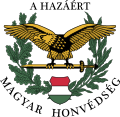Danube Guard
| Hungarian Defence Forces | |
|---|---|
| Magyar Honvédség | |
 
Flag and emblem of the Hungarian Defence Forces
|
|
| Founded | 16 May 1848 |
| Current form | 15 March 1990 |
| Service branches |
|
| Headquarters | Budapest |
| Leadership | |
| Commander-in-Chief | President János Áder |
| Minister of Defence | István Simicskó |
| Chief of staff | Colonel General Tibor Benkő |
| Manpower | |
| Military age | 18–40 years of age |
| Conscription | No (Suspended on 3 November 2004) |
| Available for military service |
2,349,948 males, age 16–49 (2010 est.), 2,290,568 females, age 16–49 (2010 est.) |
| Fit for military service |
1,902,639 males, age 16–49 (2010 est.), 1,897,378 females, age 16–49 (2010 est.) |
| Reaching military age annually |
59,237 males (2010 est.), 55,533 females (2010 est.) |
| Active personnel | 31,080 |
| Reserve personnel | 17,000 (2013) |
| Deployed personnel |
|
| Expenditures | |
| Budget | HUF350 billion ($1.21 billion; 2017) |
| Percent of GDP | 0.94% |
| Industry | |
| Foreign suppliers |
Former: |
| Related articles | |
| History | Military history of Hungary |
| Ranks | Military ranks of Hungary |
Hungarian Defence Forces (Hungarian: Magyar Honvédség) is the national defence force of Hungary. The President holds the title of commander-in-chief of the nation's armed forces. The Ministry of Defence jointly with Chief of staff administers the armed forces, including the Hungarian Ground Force and the Hungarian Air Force. Since 2007, the Hungarian Armed Forces is under a unified command structure. The Ministry of Defence maintains the political and civil control over the army. A subordinate Joint Forces Command is coordinating and commanding the HDF corps. In 2016, the armed forces had 31.080 personnel on active duty, the operative reserve brought the total number of troops to fifty thousand. In 2017, military spending will be $1.21 billion, about 0.94% of the country's GDP, well below the NATO target of 2%. In 2012, the government adopted a resolution in which it pledged to increase defence spending to 1.4% of GDP by 2022.
Military service is voluntary, though conscription may occur in wartime. In a significant move for modernization, Hungary decided in 2001 to buy 14 JAS 39 Gripen fighter aircraft for about 800 million EUR. Hungarian National Cyber Security Center is re-organized in 2016 in order to become more efficient through cyber security.
In 2016, the Hungarian military has about 700 troops stationed in foreign countries as part of international peacekeeping forces, including 100 HDF troops in the NATO-led ISAF force in Afghanistan, 210 Hungarian soldiers in Kosovo under command of KFOR, and 160 troops in Bosnia and Herzegovina. Hungary sent a 300 strong, logistics unit to Iraq in order to help the US occupation with armed transport convoys, though public opinion opposed the country's participation in the war. One soldier was killed in action because of a roadside bomb in Iraq.
...
Wikipedia
